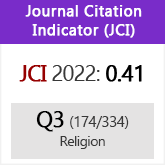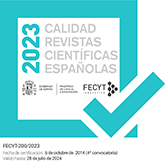Las páginas tapiz hebreas a partir de sus textos
DOI:
https://doi.org/10.3989/sefarad.020-001Palabras clave:
Biblia hebrea, Masora, micrografía, códice de Profetas de El Cairo, códice de Leningrado (B19a)Resumen
En este artículo se examinan los textos escritos en forma de decoraciones micrográficas que aparecen en las llamadas páginas tapiz de dos de los códices bíblicos hebreos más antiguos, el códice de Profetas de el Cairo y el códice de Leningrado (B19a), para analizar su posible relevancia en la evaluación y comprensión de las páginas tapiz hebreas. La lectura de estos textos revela un contenido comprensible, lleno de sentido, que no ha perdido su función como transmisor de un mensaje. También revela que el tipo de texto más usado es el de la Masora. Teniendo en cuenta los resultados, se puede concluir que la finalidad de las páginas tapiz es doble, decorativa y funcional. Estas páginas desempeñan la misma función que los márgenes de los manuscritos: recoger el material extra textual relativo al texto bíblico hebreo.
Descargas
Citas
Attiá, Elodie (2015): "Editing Medieval Ashkenazi Masorah and Masorah Figurata: Observations on the Functions of the Micrography in Hebrew Manuscripts," Sefarad 75:1, pp. 7-33. https://doi.org/10.3989/sefarad.015.001
Attiá, Elodie (2015): The Masorah of Elijah ha-Naqdan: An Edition of Ashkenazic Micrographical Notes (=Materiale Textkulturen 11; Berlin-Boston: Walter de Gruyter). https://doi.org/10.1515/9783110417920
Avrin, Leila Rachel (1975): "The Illuminations in the Moshe Ben-Asher Codex of 895 C.E.," unpublished B. Litt. Thesis (University of Michigan).
Avrin, Leila Rachel (1981) : "Micrography as Art," in Colette Sirat and Leila Avrin (eds.) La lettre hebraique et sa signification/Micrography as Art (Paris: CNRS-Editions) pp. 43-47.
Bauer, Eva (2000): "Early Bible and Quran Illuminations: Preliminary Remarks," in Benjamin H. Harry, John L. Hayes and Fred Astren (eds.) Judaism and Islam: Boundaries, Communication, and Interaction (Leiden: Brill) pp. 139-156.
Beit-Arie, Malachi, Colette Sirat, and Mordechai Glatzer (1997): Codices hebraicis litteris Extrati quo tempore scripti fuerint exhibentes, Tome I: jusqu'à 1020 (Turnhout: Brepols).
Beit-Arie, Malachi (2019): Hebrew codicology. Historical and Comparative Typology of Hebrew Medieval Codices based on the Documentation of the Extant Dated Manuscripts Using a Quantitative Approach. Available at http://web.nli.org.il/sites/NLI/Hebrew/collections/manuscripts/hebrewcodicology/Documents/Hebrew-Codicology-continuously-updated-online-version-ENG.pdf.
Díaz Esteban, Fernando (1975): Sefer Oklah we Oklah. Colección de listas de palabras destinadas a conservar la integridad del texto hebreo de la Biblia entre los judíos de la Edad Media (=Textos y estudios "Cardenal Cisneros" 4, Madrid: CSIC).
Dotan, Aron (1967): The Diqduqé hatteamim of Aharon ben Moshee ben Asher, with a Critical Edition of the Original Text from New Manuscripts (Jerusalem: The Academy of the Hebrew Language).
Dotan, Aron (2007): "Masorah," in Fred Skolnik (ed.) Encyclopaedia Judaica (2ª ed.; 22 vols., Detroit: Macmillan Reference USA) vol. 13, pp. 603-656.
Epstein, Nadine (n.d.): The Mystery of the Cairo Codex on the Trial of an Ancient Manuscript (Wisconsin).
Freedman, David N. et al. (eds.) (1998): The Leningrad Codex: A Facsimile Edition (Grand Rapids: Eerdmans).
Frensdorff, Saul (1864): Ochlah W'ochlah (Hannover: Hahn).
Ginsburg, Christian D. (1975): The Massorah Compiled from Manuscripts Alphabetically and Lexically Arranged, With an Analytical Table of Contents and Lists of Identified Sources and Parallels by Aron Dotan (4 vols., New York: Ktav).
Glatzer, Mordechai, Colette Sirat, and Malachi Beit-Arie (1999): Codices hebraicis litteris Extrati quo tempore scripti fuerint exhibentes, Tome II: de 1021 à 1079 (Turnhout: Brepols).
Gottheil, Richard J.H. (1905): "Some Hebrew Manuscripts in Cairo," JQR 17, pp. 609-655. https://doi.org/10.2307/1451043
Halperin, Dalia Ruth (2013): Illuminating in Micrography: The Catalan Micrography Mahzor-MS Heb 8°6527 in the National Library of Israel (=Medieval and Early Modern Iberian World 51; Leiden: Brill). https://doi.org/10.1163/9789004251199
Kahle, Paul (1961): Der Hebräische Bibeltext seit Franz Delitzsch (Stuttgart: Kohlhammer).
Kogman Appel, Katrin (2002): "Hebrew Manuscript Painting in Late Medieval Spain: Signs of a Culture in Transition," Art Bulletin 84:2, pp. 247-272. https://doi.org/10.2307/3177268
Kogman Appel, Katrin (2004): Jewish Book Art between Islam and Christianity. The Decoration of Hebrew Bible in Medieval Spain (Leiden: Brill).
Lebedev, Victor V. (1998): "The Oldest Complete Codex of the Hebrew Bible," in David N. Freedman et al. (eds.) The Leningrad Codex: A Facsimile Edition (Grand Rapids: Eerdmans) pp. Xxi-xxviii.
Levit-Tawil, Dalia (1994): "The Elusive, Inherited Symbolism in the Arcade Illuminations of the Moses Ben Asher Codex (A. D. 894-95)," JNES 53:3, pp. 157-193. https://doi.org/10.1086/373690
Loewinger, David Samuel (ed.) (1971): Codex Cairensis of the Bible from the Karaite Synagogue at Abbasiya (Jerusalem: Makor Publishing Ltd).
Lyons, David (1999): The Cumulative Masora. Text, Form and Transmission (Beer Sheva: Ben-Gurion University, in Hebrew).
Martín-Contreras, Elvira and Guadalupe Seijas de los Ríos (2010): Masora. La transmisión de la tradición de la Biblia Hebrea (Estella: Verbo Divino).
Martín-Contreras, Elvira (2013): "Masora and Masoretic Interpretation," in Steven L. McKenzie (ed.) The Oxford Encyclopedia of Biblical Interpretation (2 vols., Oxford: Oxford University Press) vol. 1, pp. 542-550.
Martín-Contreras, Elvira (2016): "The Image at the Service of the Text: Figured Masorah in the Biblical Hebrew Manuscript BH Mss1," Sefarad 76:1, pp. 55-74. https://doi.org/10.3989/sefarad.016.002
Martín-Contreras, Elvira (2018): "Confirming what is Written: The Masoretic Term Yafeh," Vetus Testamentum 55, pp. 606-619. https://doi.org/10.1163/15685330-12341340
Martín-Contreras, Elvira (2020): "A New List of Words that Occur Twice with Two Different Meanings found in The Leningrad Codex B19a," Textus 29, pp. 1-9. https://doi.org/10.1163/2589255X-02901001
Milstein, Rachel (1999): "Hebrew Book Illustration in the Fatimid Period," in Marianne Barrucand (ed.) L'Egypte fatimide: Son Art and son histoire (Paris: Presses de l'Université de Paris-Sorbonne) pp. 429-440.
Narkiss, Bezalel (1990): Illuminations from Hebrew Bibles of Leningrad (Jerusalem: The Bialik Institute).
Ofer, Yosef (2018): "An Ancient Masoretic Comment in Carpet Leaves of a Torah Manuscript by Shmuel ben Yaakov" [in Hebrew], Leshonenu 80, pp. 29-52.
Ognibeni, Bruno (1995): La seconda parte del Sefer Oklah weOklah. Edizione del ms. Halle, Universitätsbibliothek Y v 4º, ff. 68-124 (=Textos y estudios "Cardenal Cisneros" 57; Madrid: CSIC).
Outhwaite, Ben (2017): "The first owners of the Leningrad Codex: T-S 10J30.7;" available at https://doi.org/10.17863/CAM.28071.
Pérez Castro, Federico et al. (1979-1992): El Códice de Profetas de El Cairo (8 vols., Madrid: CSIC).
Pérez Castro, Federico et al. (1983): El Códice de Profetas de El Cairo: Samuel (=Textos y estudios "Cardenal Cisneros" 30; Madrid: CSIC).
Pérez Castro, Federico et al. (1980): El Códice de Profetas de El Cairo: Josue-Jueces (=Textos y estudios "Cardenal Cisneros" 26; Madrid: CSIC).
Pérez Castro, Federico et al. (1984): El Códice de Profetas de El Cairo: Reyes (=Textos y estudios "Cardenal Cisneros" 31; Madrid: CSIC).
Pérez Castro, Federico et al. (1986): El Códice de Profetas de El Cairo: Isaias (=Textos y estudios "Cardenal Cisneros" 36; Madrid: CSIC).
Pinder Wilson, Ralph H. and Richard Ettinghausen (1961): "The Illuminations in the Cairo Mosche b. Asher Codex of the Prophets completed in Tiberias in 895 AD," in Paul Kalhe (ed.) Der Hebräische Bibeltext seit Franz Delitzsch (Stuttgart: Kohlhammer) pp. 95-98.
Revell, Ernest J. (trans.) (1998): "The Leningrad Codex as Representative of the Masoretic Text," in David N. Freedman et al. (eds.) The Leningrad Codex: A Facsimile Edition (Grand Rapids: Eerdmans, 1998) pp. Xxix-xlvi.
Halperin, Dalia Ruth (2019): "Clockwise-Counterclockwise: Calligraphic Frames in Sefardi Hebrew Bibles and Their Roots in Mediterranean Culture," Manuscript Studies, the journal of the Schoenberg Institute for Manuscript Studies 4:2, pp. 231-269. https://doi.org/10.1353/mns.2019.0013
Schmidt, Susan (2019): "The Carpet Illuminations of Codex Leningrad, National Library of Russia Firk. Ms. EBP. I B 19a," unpublished B. Litt. Thesis (University of the Holy Land).
Sed-Rajna, Gabrielle (1975): "Toledo or Burgos?," Journal of Jewish Art 2, pp. 6-21.
Sed-Rajna, Gabrielle (1992): "Hebrew illuminated manuscripts from the Iberian Peninsula," in Vivian B. Mann et al. (eds.) Convivencia; Jews, Muslims, and Christians in Medieval Spain (New York: G. Braziller in association with the Jewish Museum) pp. 133-155.
Sirat, Colette, Malachi Beit-Arie, and Mordechai Glatzer (2001): Codices hebraicis litteris Extrati quo tempore scripti fuerint exhibentes, Tome III: 1085-1140 (Turnhout: Brepols).
Stern, David (2008): "The First Jewish Books and the Early History of Jewish Reading," JQR 2, pp. 163-202. https://doi.org/10.1353/jqr.0.0005
Stern, David (2017): The Jewish Bible: A Material History (Seattle: University of Washington Press).
Ward, Gerald W. R. (ed.) (2008): The Grove Encyclopedia of Materials and Techniques in Art (Oxford: Oxford University Press).
Yeivin, Israel (1976): Introduction to the Tiberian Masorah. Translated by Ernest J. Revell (=Masoretic Studies 5; Missoula, Montana: Scholars Press).
Descargas
Publicado
Cómo citar
Número
Sección
Licencia
Derechos de autor 2020 Consejo Superior de Investigaciones Científicas (CSIC)

Esta obra está bajo una licencia internacional Creative Commons Atribución 4.0.
© CSIC. Los originales publicados en las ediciones impresa y electrónica de esta Revista son propiedad del Consejo Superior de Investigaciones Científicas, siendo necesario citar la procedencia en cualquier reproducción parcial o total.Salvo indicación contraria, todos los contenidos de la edición electrónica se distribuyen bajo una licencia de uso y distribución “Creative Commons Reconocimiento 4.0 Internacional ” (CC BY 4.0). Puede consultar desde aquí la versión informativa y el texto legal de la licencia. Esta circunstancia ha de hacerse constar expresamente de esta forma cuando sea necesario.
No se autoriza el depósito en repositorios, páginas web personales o similares de cualquier otra versión distinta a la publicada por el editor.














